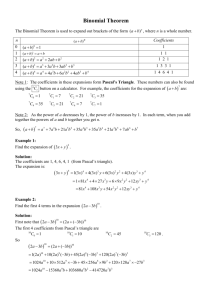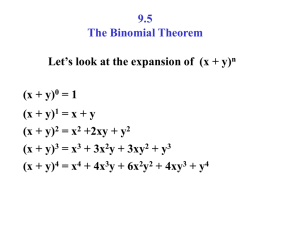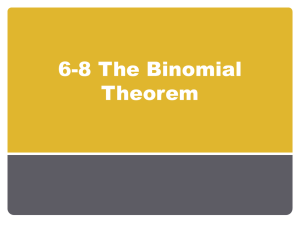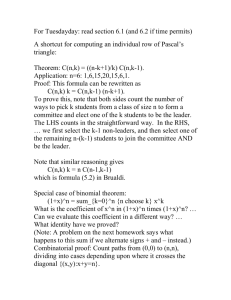the binomial theorem
advertisement
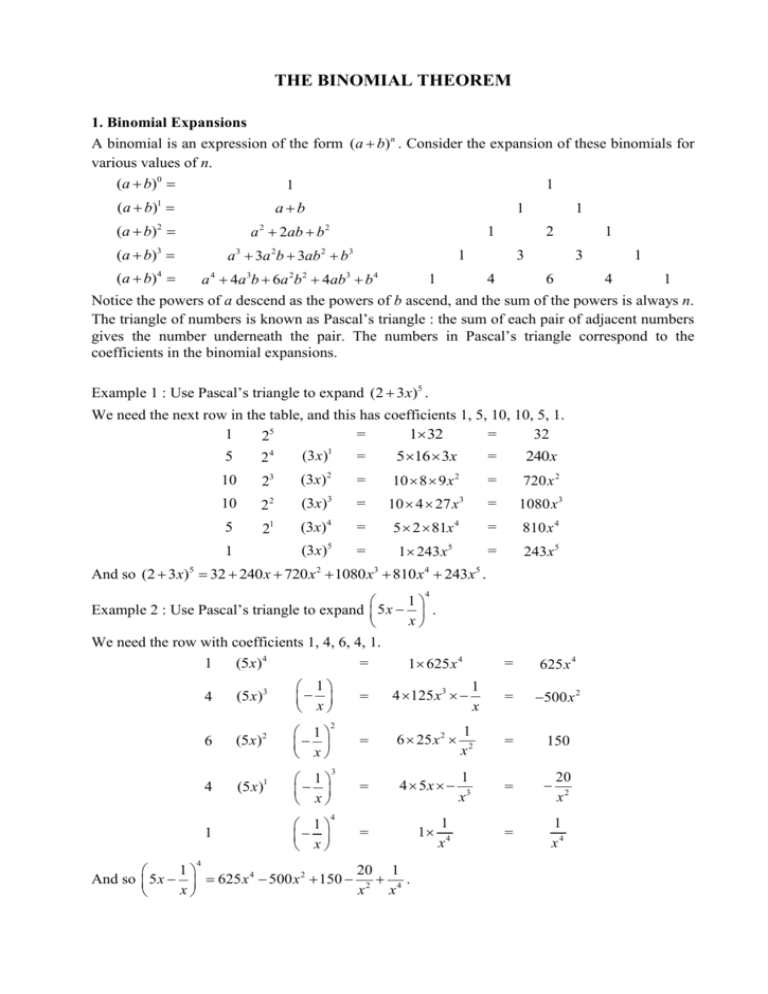
THE BINOMIAL THEOREM 1. Binomial Expansions A binomial is an expression of the form (a b)n . Consider the expansion of these binomials for various values of n. (a b)0 1 1 (a b)1 a b (a b) a 2ab b (a b) a 3a b 3ab b 2 2 3 3 (a b) 2 1 2 1 2 3 1 2 1 1 3 3 1 1 4 6 4 1 a 4a b 6a b 4ab b Notice the powers of a descend as the powers of b ascend, and the sum of the powers is always n. The triangle of numbers is known as Pascal’s triangle : the sum of each pair of adjacent numbers gives the number underneath the pair. The numbers in Pascal’s triangle correspond to the coefficients in the binomial expansions. 4 4 3 2 2 3 4 Example 1 : Use Pascal’s triangle to expand (2 3x)5 . We need the next row in the table, and this has coefficients 1, 5, 10, 10, 5, 1. 1 = = 32 1 32 25 (3 x)1 5 = = 5 16 3x 240x 24 10 23 (3x)2 = 10 8 9x 2 = 720x 2 10 22 (3x)3 = 10 4 27x3 = 1080x 3 5 21 (3x)4 = 5 2 81x 4 = 810x 4 (3x)5 = 1 243x 5 = 243x5 1 And so (2 3x)5 32 240 x 720 x 2 1080 x3 810 x 4 243x5 . 4 1 Example 2 : Use Pascal’s triangle to expand 5x . x We need the row with coefficients 1, 4, 6, 4, 1. 1 (5 x)4 4 (5 x)3 1 x 6 (5 x)2 1 x 4 1 1 4 (5 x) = 1 x = 625x 4 = 500x 2 = 4 125x 3 = 6 25x 2 1 x2 = 150 = 4 5x 1 x3 = = 1 2 1 x 1 x 1 625x 4 3 4 1 20 1 And so 5 x 625 x 4 500 x 2 150 2 4 . x x x 1 x4 = 20 x2 1 x4 Example 3 : Find the coefficient of x 3 in the expansion of (7 2 x)5 . Here we do not need to find the full expansion, just the term in x 3 . 1 5 10 (2 x)3 = 10 49 8x3 = 3920x 3 10 72 5 1 3 The coefficient of x is −3920. Example 4 : Find the coefficient of x 5 in the expansion of (3x 1)7 . We need to continue Pascal’s triangle down a few rows. 1 7 21 (3x)5 = 21 243x5 1 12 = 5103x5 The coefficient of x 5 is 5103. Example 5 : Find the coefficient of x 2 in the expansion of (1 2 x)(3x 5)3 . We first expand (3x 5)3 … 1 (3x)3 3 (3x)2 3 (3 x)1 1 = 1 27x 3 = 27x 3 (5)1 = 3 9 x 2 5 = 135x 2 (5)2 = 3 3x 25 = 225x (5)3 = 1 125 = 125 And then multiply by (1 2 x) , only bothering to find those terms involving x 2 . 27x 3 135x 2 225x 125 1 135x 2x 450x 2 The coefficient of x is −585. Note that if we were far-sighted enough, we would only bother finding the terms in x and x 2 in the expansion of (3x 5)3 . 2 C2 p72 Ex 5A 2. Formulas for Binomial Coefficients The numbers in Pascal’s triangle are called binomial coefficients. In most cases, it is not too much trouble to write the triangle out as far as you need, but for large powers – the value of n in (a b)n – this would be time-consuming. So we will now obtain formulas for binomial coefficients. But first, some notation. Consider the term involving b r in the expansion of (a b)n . We use the n notation , alternatively denoted nCr in probability theory, to identify the coefficient, and so r n this particular term is a n r b r . r The table below shows Pascal’s triangle rewritten with n and r. r 0 1 2 3 4 0 1 1 1 1 2 1 2 1 n 3 1 3 3 1 4 1 4 6 4 1 5 1 5 10 10 5 6 1 6 15 20 15 6 4 5 So for example, 15 , 1 , 5 . 2 0 4 5 6 1 6 1 The formula for the binomial coefficients is... n n! r r ! n r ! For example, 7 7! 2 2!5! 7 6 5 4 3 2 1 2 1 5 4 3 2 1 21 All scientific calculators have an nCr button. On a graphic calculator, to get 7C2 , type 7 OPTN F6 F3 (to get PROB) F3 (to get nCr) 2 EXE. C2 p73 Ex 5B We can write binomial expansions in this notation. 3 3 3 3 (a b)3 a3 a 2b ab 2 b3 0 1 2 3 5 5 5 5 5 5 (a b)5 a 5 a 4b a 3b 2 a 2b3 ab 4 b5 0 1 2 3 4 5 In general we have the binomial theorem... n n n n n 1 n n (a b) n a n a n 1b a n 2b 2 ... ab b 0 1 2 n 1 n Example 1 : Use the binomial theorem to expand (3 2 x)5 . 5 5 5 5 5 5 (3 2 x)5 35 34 (2 x) 33 (2 x) 2 32 (2 x) 3 3(2 x) 4 (2 x) 5 0 1 2 3 4 5 2 3 4 5 1 243 5 162 x 10 108 x 10 72 x 5 48 x 32 x 243 810 x 1080 x 2 720 x 3 240 x 4 32 x 5 You can get the coefficients from your calculator or straight from Pascal’s triangle if you prefer. 4 1 Example 2 : Expand 2x 2 . x 4 2 3 4 4 1 4 1 4 1 4 1 4 1 4 3 2 2 x 2 0 (2 x) 1 (2 x) 2 2 (2 x) 2 3 (2 x) 2 4 2 x x x x x 4 2 1 116 x 4 4 8 x 6 2 4 5 1 8 x x x 24 8 1 16 x 4 32 x 2 5 8 x x x Example 3 : Find the term in x 3 in the expansion of (2 3x)8 The required term is 8 5 3 3 2 (3 x) 56 32 27 x 3 48384 x3 Example 4 : Find the term in x 4 in the expansion of (7 x 2)9 The required term is 9 4 5 4 (7 x) (2) 126 2401x 32 5 9680832 x3 6 1 Example 5 : Find the constant term in the expansion of 5x 2 . x 1 to the power 2. x2 You may be able to see that we need to raise 5x to the power 4 and So the required term is 6 1 4 1 4 (5 x) 2 15 625 x 4 x x 2 9375 2 Example 6 : Find the term in x8 in the expansion of x x Here, we need to raise x to the power 4 and 12 . x to the power 8. So the required term is 12 4 x 8 x 8 495 x 4 x 4 495 x8 Also useful is a special case of the binomial theorem... n n n (1 x) n 1 x x 2 x3 ... x n 1 2 3 …since all the powers of 1 are all worth 1. 4 Example 7 : Use the binomial theorem to expand 1 x . Hence write 1 3 simplest form. 1 x 4 4 1 1 4 x 2 2 x 4 3 3 x 1 4 x 6x 4x x x2 1 3 4 1 4 3 6 3 4 3 3 32 28 16 3 C2 p75 Ex 5C Q1-6, p76 Ex 5D Q1 x 4 4 in its 3. Approximations Using the Binomial Theorem If successive terms of a binomial expansion get smaller and smaller, we can ignore negligible terms and hence make approximations. Example 1 : Expand (1 2 x)5 up to and including the term in x 3 . Hence find an approximation for 1.025 . 5 5 5 (1 2 x)5 1 (2 x) (2 x) 2 (2 x)3 ... 1 2 3 1 10 x 40 x 2 80 x3 ... Substituting x 0.01, (1.02)5 1 10 0.01 40 0.0001 80 0.000001 ... 1.10408 This compares favourably with the true value of 1.1040808032 Example 2 : Find the expansion of (2 3x)10 up to and including the term in x 3 . Hence find an approximation for 1.9710 . 10 10 10 10 (2 3x)10 210 29 (3 x) 28 (3 x) 2 27 (3 x)3 ... 0 1 2 3 1024 15360 x 103680 x 2 414720 x3 ... Substituting x 0.01, 1.9710 1024 15360 0.01 103680 0.0001 414720 0.000001 ... 880.35328 This agrees with the true value to one decimal place. Example 3 : If x is so small that terms of x 3 and higher can be ignored, show that ( x 2)(3 2 x)5 486 1377 x 1350 x 2 . Expanding the binomial, (3 2 x)5 1 35 5 34 (2 x) 10 33 (2 x) 2 243 810 x 1080 x 2 We then multiply by ( x 2) , only bothering to find those terms involving x 2 or lower. x 2 243 810x 1080x 2 243x 486 810x 2 1620x 2160x 2 The expansion is therefore 486 1377 x 1350 x 2 . The graphs on the next page show that this is a reasonable approximation for values of x close to zero. The solid line is y ( x 2)(3 2 x)5 and the dotted line is y 486 1377 x 1350 x 2 . y 2000 1500 1000 500 – 1 – 0.8 – 0.6 – 0.4 – 0.2 0.2 0.4 0.6 0.8 1 x C2 p75 Ex 5C Q7-8, p76 Ex 5D Q2,3,5 4. Problems Where the Power is Unknown We can write... n n! 1 0 0!n ! n n! n 1 1!(n 1)! n n! n(n 1) 2! 2 2!(n 2)! n n! n(n 1)(n 2) 3! 3 3!( n 3)! ...and so on. This is useful when the power of the binomial is unknown, as in the following examples. Example 1 : In the expansion of (1 3x)n , the coefficient of x 2 is 105. Find the value of n. n 2 2 (3 x) 105 x 2 n(n 1) 9 105 2! n(n 1) 30 n 2 n 30 0 (n 6)(n 5) 0 n6 We reject the negative root (for now – we will accept it when we get to unit C4!) Example 2 : In the expansion of (1 px) q , the coefficients of x and x 2 are –28 and 336 respectively. Find the values of p and q. (1 px) q 1 q( px) q (q 1) ( px) 2 ... 2! Comparing coefficients, we have pq 28 q (q 1) 2 p 336 2! Rearranging the first equation… 28 q 784 p2 2 q p …and substituting in the second, q(q 1) 784 2 336 2! q 392(q 1) 336 q 392q 392 336q 56q 392 q7 p 4 Example 3 : In the expansion of (a x)(1 x) n , the first two terms are 3 16x . Find the values of a and n, and find the coefficients of x 2 and x 3 . n(n 1) 2 n(n 1)(n 2) 3 (a x)(1 x) n (a x) 1 nx x x ... 2! 3! an(n 1) 2 n(n 1) an(n 1)(n 2) 3 a (1 an) x n x x ... 2! 3! 2! The first two terms are 3 16x , and so a3 1 an 16 1 3n 16 n5 Substituting into the formulas above for the coefficients of x 2 and x 3 gives us 3 5 4 coefficient of x 2 5 35 2 5 4 3 5 4 3 coefficient of x 3 40 2 6 C2 p76 Ex 5D Q4, p77 Ex 5E Q1,6 Topic Review : Binomial Theorem
